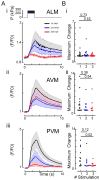Pneumatic stimulation of C. elegans mechanoreceptor neurons in a microfluidic trap
- PMID: 28207921
- PMCID: PMC5360562
- DOI: 10.1039/c6lc01165a
Pneumatic stimulation of C. elegans mechanoreceptor neurons in a microfluidic trap
Abstract
New tools for applying force to animals, tissues, and cells are critically needed in order to advance the field of mechanobiology, as few existing tools enable simultaneous imaging of tissue and cell deformation as well as cellular activity in live animals. Here, we introduce a novel microfluidic device that enables high-resolution optical imaging of cellular deformations and activity while applying precise mechanical stimuli to the surface of the worm's cuticle with a pneumatic pressure reservoir. To evaluate device performance, we compared analytical and numerical simulations conducted during the design process to empirical measurements made with fabricated devices. Leveraging the well-characterized touch receptor neurons (TRNs) with an optogenetic calcium indicator as a model mechanoreceptor neuron, we established that individual neurons can be stimulated and that the device can effectively deliver steps as well as more complex stimulus patterns. This microfluidic device is therefore a valuable platform for investigating the mechanobiology of living animals and their mechanosensitive neurons.
Figures






Similar articles
-
Using a Microfluidics Device for Mechanical Stimulation and High Resolution Imaging of C. elegans.J Vis Exp. 2018 Feb 19;(132):56530. doi: 10.3791/56530. J Vis Exp. 2018. PMID: 29553526 Free PMC article.
-
A new platform for long-term tracking and recording of neural activity and simultaneous optogenetic control in freely behaving Caenorhabditis elegans.J Neurosci Methods. 2017 Jul 15;286:56-68. doi: 10.1016/j.jneumeth.2017.05.017. Epub 2017 May 12. J Neurosci Methods. 2017. PMID: 28506879
-
A Microfluidic Platform for Longitudinal Imaging in Caenorhabditis elegans.J Vis Exp. 2018 May 2;(135):57348. doi: 10.3791/57348. J Vis Exp. 2018. PMID: 29782012 Free PMC article.
-
Microfluidic systems for high-throughput and high-content screening using the nematode Caenorhabditis elegans.Lab Chip. 2017 Nov 7;17(22):3736-3759. doi: 10.1039/c7lc00509a. Lab Chip. 2017. PMID: 28840220 Review.
-
Microfluidic Approaches for Protein Crystal Structure Analysis.Anal Sci. 2016;32(1):3-9. doi: 10.2116/analsci.32.3. Anal Sci. 2016. PMID: 26753699 Review.
Cited by
-
Using a Microfluidics Device for Mechanical Stimulation and High Resolution Imaging of C. elegans.J Vis Exp. 2018 Feb 19;(132):56530. doi: 10.3791/56530. J Vis Exp. 2018. PMID: 29553526 Free PMC article.
-
Scalable Electrophysiology of Millimeter-Scale Animals with Electrode Devices.BME Front. 2023 Dec 7;4:0034. doi: 10.34133/bmef.0034. eCollection 2023. BME Front. 2023. PMID: 38435343 Free PMC article. Review.
-
Comparing Caenorhabditis elegans gentle and harsh touch response behavior using a multiplexed hydraulic microfluidic device.Integr Biol (Camb). 2017 Oct 16;9(10):800-809. doi: 10.1039/c7ib00120g. Integr Biol (Camb). 2017. PMID: 28914311 Free PMC article.
-
The mechanobiology of biomolecular condensates.Biophys Rev (Melville). 2025 Mar 25;6(1):011310. doi: 10.1063/5.0236610. eCollection 2025 Mar. Biophys Rev (Melville). 2025. PMID: 40160200 Free PMC article. Review.
-
Loss of CaMKI Function Disrupts Salt Aversive Learning in C. elegans.J Neurosci. 2018 Jul 4;38(27):6114-6129. doi: 10.1523/JNEUROSCI.1611-17.2018. Epub 2018 Jun 6. J Neurosci. 2018. PMID: 29875264 Free PMC article.
References
-
- Reits EA, Neefjes JJ. Nature Cell Biology. 2001;3:E145–E147. - PubMed
Publication types
MeSH terms
Substances
Grants and funding
LinkOut - more resources
Full Text Sources
Other Literature Sources

